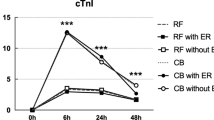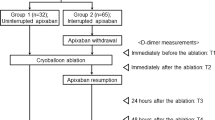Summary
Background
Evidence from animal and human studies suggests that cryoablation might be associated with a lesser inflammatory response and activation of coagulation compared with radiofrequency ablation. The study was aimed at comparing the effect of cryoballoon and radiofrequency catheter ablation of paroxysmal atrial fibrillation on markers of myocardial damage, inflammation, and activation of coagulation.
Methods
Forty-one patients received either cryoballoon (n = 23) or radiofrequency (n = 18) ablation of atrial fibrillation. We measured troponin I, high-sensitivity CRP, and interleukin 6 at baseline from the cubital vein, and from the right and left atrium before and after ablation, and from the cubital vein the following day. Prothrombin fragments 1 + 2, soluble P‑selectin, and D‑dimer were measured before and after ablation from both atria.
Results
We observed higher troponin I release in the cryoballoon than in the radiofrequency group (7.01 mcg/l (interquartile range [IQR]: 5.30–9.09) vs 2.32 mcg/l (IQR: 1.45–2.98), p < 0.001). The levels of inflammatory markers (high-sensitivity CRP and interleukin 6) in the two groups were comparable, as were the levels of markers of coagulation activation. Procedure duration, fluoroscopy times, and mid-term success (23 months, IQR 7–32) of the two groups were also comparable.
Conclusions
Cryoballoon ablation of atrial fibrillation causes more significant myocardial damage, that is, more extensive ablation lesions, compared with radiofrequency catheter ablation. However, no major differences between these two ablation techniques with regard to the inflammatory response and activation of the coagulation system were observed.





Similar content being viewed by others
References
Friberg J, Scharling H, Gadsbøll N, et al. Sex-specific increase in the prevalence of atrial fibrillation (The Copenhagen City Heart Study). Am J Cardiol. 2003;92(12):1419–23.
Heeringa J, Kuip DA van der, Hofman A, Kors, et al. Prevalence, incidence and lifetime risk of atrial fibrillation: the Rotterdam study. Eur Heart J. 2006;27(8):949–53.
Stewart S, Hart CL, Hole DJ, et al. A population-based study of the long-term risks associated with atrial fibrillation: 20-year follow-up of the Renfrew/Paisley study. Am J Med. 2002;113(5):359–64.
Mugnai G, Chierchia GB, Asmundis C de, et al. Comparison of pulmonary vein isolation using cryoballoon versus conventional radiofrequency for paroxysmal atrial fibrillation. Am J Cardiol. 2014;113(9):1509–13.
Neumann T, Vogt J, Schumacher B, et al. Circumferential pulmonary vein isolation with thecryoballoon technique results from a prospective 3‑center study. J Am Coll Cardiol. 2008;52(4):273–8.
Van Belle Y, Janse P, Theuns D, et al. One year follow-up after cryoballoon isolation of the pulmonary veins in patients with paroxysmal atrial fibrillation. Europace. 2008;10(11):1271–6.
Sata N, Hamada N, Horinouchi T, et al. C‑reactive protein and atrial fibrillation. Is inflammation a consequence or a cause of atrial fibrillation? Jpn Heart J. 2004;45(3):441–5.
Engelmann MD, Svendsen JH. Inflammation in the genesis and perpetuation of atrial fibrillation. Eur Heart J. 2005;26(20):2083–92.
Chung MK, Martin DO, Sprecher D, et al. C‑reactive protein elevation in patients with atrial arrhythmias: inflammatory mechanisms and persistence of atrial fibrillation. Circulation. 2001;104(24):2886–91.
McCabe JM, Smith LM, Tseng ZH, et al. Protracted CRP elevation after atrial fibrillation ablation. Pacing Clin Electrophysiol. 2008;31(9):1146–51.
Ryu K, Li L, Khrestian CM, Matsumoto N, et al. Effects of sterile pericarditis on connexins 40 and 43 in the atria: correlation with abnormal conduction and atrial arrhythmias. Am J Physiol Heart Circ Physiol. 2007;293(2):H1231–41.
Lip GY, Patel JV, Hughes E, et al. High-sensitivity C‑reactive protein and soluble CD40 ligand as indices of inflammation and platelet activation in 880 patients with nonvalvular atrial fibrillation: relationship to stroke risk factors, stroke risk stratification schema, and prognosis. Stroke. 2007;38(4):1229–37.
Kongsgaard E, Foerster A, Aass H, et al. Power and temperature guided radiofrequency catheter ablation of the right atrium in pigs. Pacing Clin Electrophysiol. 1994;17(10):1610–20.
Lijnen HR, Collen D. Endothelium in hemostasis and thrombosis. Prog Cardiovasc Dis. 1997;39(4):343–50.
Khairy P, Chauvet P, Lehmann J, et al. Lower incidence of thrombus formation with cryoenergy versus radiofrequency catheter ablation. Circulation. 2003;107(15):2045–50.
Rodriguez LM, Leunissen J, Hoekstra A, et al. Transvenous cold mapping and cryoablation of the AV node in dogs: observations of chronic lesions and comparison to those obtained using radiofrequency ablation. J Cardiovasc Electrophysiol. 1998;9(10):1055–61.
Oswald H, Gardiwal A, Lissel C, et al. Difference in humoral biomarkers for myocardial injury and inflammation in radiofrequency ablation versus cryoablation. Pacing Clin Electrophysiol. 2007;30(7):885–90.
Kubala M, Hermida JS, Nadji G, et al. Normal pulmonary veins anatomy is associated with better AF-free survival after cryoablation as compared to atypical anatomy with common left pulmonary vein. Pacing Clin Electrophysiol. 2011;34(7):837–43.
De Ponti R, Zardini M, Storti C, et al. Trans-septal catheterization for radiofrequency catheter ablation of cardiac arrhythmias. Results and safety of a simplified method. Eur Heart J. 1998;19(6):943–50.
Herrera SC, Arentz T, Minners J, et al. Cellular damage, platelet activation, and inflammatory response after pulmonary vein isolation: a randomized study comparing radiofrequency ablation with cryoablation. Heart Rhythm. 2012;9(2):189–96.
Malmborg H, Christersson C, Lönnerholm S, et al. Comparison of effects on coagulation and inflammatory markers using a duty-cycled bipolar and unipolar radiofrequency pulmonary vein ablation catheter vs. a cryoballoon catheter for pulmonary vein isolation. Europace. 2013;15(6):798–804.
Schmidt M, Marschang H, Clifford S, Harald R, Guido R, Oliver T, et al. Trends in inflammatory biomarkers during atrial fibrillation ablation across different catheter ablation strategies. Int J Cardiol. 2012;158(1):33–8.
Kühne M, Suter Y, Altmann D, Ammann P, Schaer B, Osswald S, et al. Cryoballoon versus radiofrequency catheter ablation of paroxysmal atrial fibrillation: biomarkers of myocardial injury, recurrence rates, and pulmonary vein reconnection patterns. Heart Rhythm. 2010;7(12):1770–6.
Pfäfflin A, Schleicher E. Inflammation markers in point-of-care testing (POCT). Anal Bioanal Chem. 2009;393(5):1473–80.
Baidoshvili A, Nijmeijer R, Lagrand WK, et al. Localisation of C reactive protein in infarcted tissue sites of multiple organs during sepsis. J Clin Pathol. 2002;55(2):152–3.
Krijnen PA, Ciurana C, Cramer T, et al. IgM colocalises with complement and C reactive protein in infarcted human myocardium. J Clin Pathol. 2005;58(4):382–8.
Author information
Authors and Affiliations
Corresponding author
Ethics declarations
Conflict of interest
B. Antolič, A. Pernat, M. Cvijić, D. Žižek, M. Jan, and M. Šinkovec state that there are no conflicts of interest.
Ethical standards
Informed consent to be included in the study was obtained from all patients. The procedures used in this evaluation were in accordance with the Declaration of Helsinki (1964) and its later amendments. The study was approved by the Ethics Committee of the Slovenian Ministry of Health.
Rights and permissions
About this article
Cite this article
Antolič, B., Pernat, A., Cvijić, M. et al. Radiofrequency catheter ablation versus balloon cryoablation of atrial fibrillation: markers of myocardial damage, inflammation, and thrombogenesis. Wien Klin Wochenschr 128, 480–487 (2016). https://doi.org/10.1007/s00508-016-1002-0
Received:
Accepted:
Published:
Issue Date:
DOI: https://doi.org/10.1007/s00508-016-1002-0




